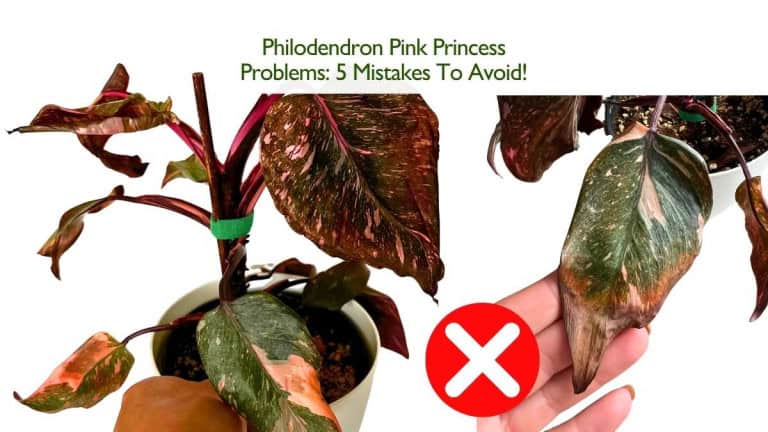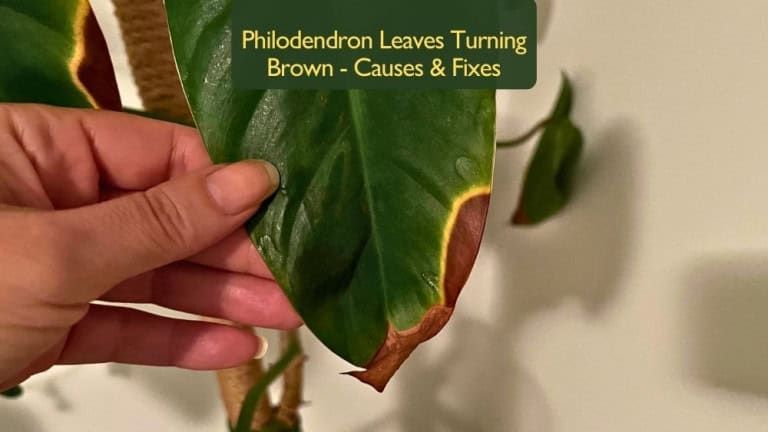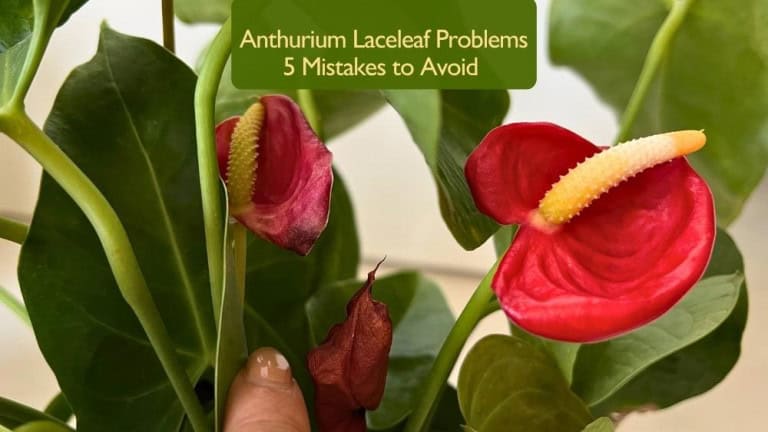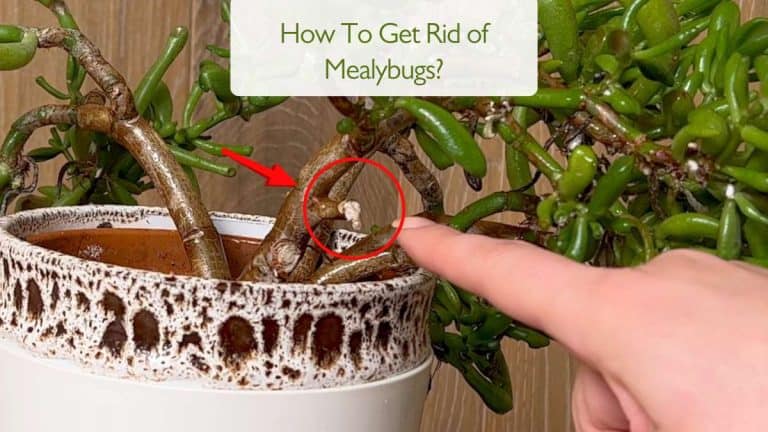Philodendron Pink Princess Problems: 5 Mistakes to Avoid
The Philodendron Pink Princess is one of the most admired houseplants, thanks to its striking pink variegation and climbing growth habit. But as beautiful as it is, this plant can also be quite sensitive. Many owners quickly notice that keeping the leaves healthy and the pink color vibrant takes consistent care. If you’re struggling, you’re not alone. In this article, I’ll explore the most common Philodendron Pink Princess problems and the five mistakes you should avoid to keep your plant thriving.
📺 If you’re just getting started and want the full care basics first, watch my video: How to Care for Philodendron Pink Princess – Everything You Need to Know! or read the full article here.
Click here to watch the video on YouTube
1. Providing the Wrong Amount of Light
Light plays a huge role in keeping your Pink Princess happy. Too much direct sun, especially harsh midday rays, can scorch the delicate variegated leaves and leave brown burn spots. On the other hand, too little light causes the pink variegation to fade, with new leaves appearing mostly green.
From my own experience this year, I tested what happens if you give a Philodendron Pink Princess more direct sun. In April, I moved my older plant to a west-facing window. At first, I introduced the sunlight gradually, letting it adapt step by step. By summer, it was receiving about four hours of direct sun each day. Surprisingly, it never showed any signs of burning. Quite the opposite – the leaves became larger and the variegation turned even more interesting.
I should note that my window glass has a UV protection layer, which may have softened the strongest rays. Still, this experiment showed me that if the plant is introduced to sunlight gradually, the Pink Princess can tolerate – and even benefit from strong light and some direct sun. See the image below:

To sum it up: if you have bright conditions, don’t be afraid to experiment. Just introduce the light slowly so the plant can adapt, and you might be rewarded with more dramatic growth and variegation. Strong light is often at the root of Philodendron Pink Princess problems, but when managed correctly, it can actually become the secret to healthier leaves.
2. Overwatering and Poor Drainage
One of the most common Philodendron Pink Princess problems is overwatering. This plant dislikes sitting in soggy soil, and roots that stay wet too long begin to rot. Signs include yellowing leaves, mushy stems, and slowed growth.
The key is to water based on soil dryness, not on a strict schedule. Check the top two inches – if dry, water thoroughly and let the excess drain away. Always keep your PPP in a pot with proper drainage holes. Root health depends on both your watering routine and the type of soil you use.
If your plant is already showing signs of soft stems or early root rot, don’t wait too long to act. I’ve created a full step-by-step guide showing exactly how I rescue a struggling Philodendron Pink Princess, including how to trim, clean, and restart healthy roots.
You can watch the full propagation and root rot rescue video below:
Click here to watch the video on YouTube
3. Using the Wrong Soil Mix as Philodendron Pink Princess Problems
Soil can either help your plant thrive or slowly damage it. Heavy, compact soil holds too much water and prevents oxygen from reaching the roots. This often leads to stunted growth and root rot – very common Philodendron Pink Princess problems.
A healthy PPP needs a chunky, airy, well-draining mix. A blend of orchid bark, perlite, and coco coir or peat moss creates the perfect balance. It holds enough moisture for the roots but allows water to drain freely. For best results, I recommend my Aroid Soil Mix Recipe, which is suitable for Philodendrons and many other aroids.
Many Philodendron Pink Princess problems start from the wrong soil mix. If the roots can’t breathe, the plant struggles, no matter how perfect your light or watering routine is.
4. Ignoring Humidity and Temperature Needs

The Pink Princess is a tropical plant, and when it’s exposed to dry air or sudden drafts, problems appear quickly. Crispy brown edges are often linked to low humidity, while growth may slow if your plant is near a drafty window or air conditioning vent.
To avoid these issues, aim for humidity around 60% or higher. A humidifier works best, but pebble trays and grouping plants together also help. Keep temperatures steady between 65–80°F (18–27°C). Consistency is more important than perfection, so avoid moving your plant between very different environments.
Low humidity and unstable temperatures are among the most overlooked Philodendron Pink Princess problems, but fixing them often makes the leaves recover faster and new growth appear healthier.
5. Ignoring Leaf Problems: Yellowing, Browning, and Curling
Leaves are the clearest indicators of Philodendron Pink Princess problems, but many owners overlook them until it’s too late.

Example of leaf damage caused by poor conditions – this plant was placed in an east-north window with insufficient light, low humidity, and signs of overwatering. Notice the browning and curling on multiple leaves.
Yellowing leaves are often caused by overwatering or low light, though sometimes it’s just the plant naturally shedding older leaves. Browning tips and edges usually point to low humidity, inconsistent watering, or fertilizer burn. Curling leaves may mean the plant is thirsty, exposed to too much direct light, or dealing with pests like spider mites.
The mistake is ignoring these signs. A single yellow leaf isn’t alarming, but if it spreads across the plant, your care routine needs adjusting. Think of the leaves as your plant’s way of telling you what’s wrong. By paying close attention, you can address small issues before they become bigger problems.
Since leaves react first, solving these Philodendron Pink Princess problems early will save you from bigger setbacks and keep your plant’s variegation beautiful.
How to Keep Your Philodendron Pink Princess Thriving
At first, Philodendron Pink Princess problems can feel discouraging. But once you understand these five mistakes and how to avoid them, caring for this plant becomes much simpler. Balance is everything: the right light, careful watering, airy soil, stable humidity, and watching for leaf signals. With the right adjustments, your Pink Princess will reward you with those breathtaking pink-and-green leaves that make it one of the most prized houseplants in the world.
For a detailed step-by-step guide, make sure to read my full Philodendron Pink Princess Care Tips.
Related Topics for Philodendron Pink Princess problems
- How to Propagate Philodendron Pink Princess + Root Rot
- How to Water Houseplants Properly
- My Aroid Soil Mix Recipe
- How to Get Rid of Mealybugs on Houseplants
- Spider Mite Protection for Houseplants
- Plant Watering Planners – stay consistent with your watering routine
💚 Have you faced any Philodendron Pink Princess problems? Share your experience in the comments below and let’s help each other grow healthier, more vibrant plants.
🌱 Try My Plant Sound Therapy Sessions
Along with plant care tips, I also create special sound therapy frequencies designed to support healthy growth, stronger roots, pest protection, and even flowering. These are unique audio tracks that you can play for your plants at home.
👉 Explore the full collection here: Plant Sound Therapy
Popular choices include:
- Plant Growth Frequency (45 min) – supports stronger, faster growth
- Flowering & Fruiting Frequency (18 min) – encourages bigger blooms and higher yields
- Spider Mite Protection (16 min) – helps plants stay healthy under stress
Your plants will love the extra care 💚
Click here to watch the video on YouTube
Explore More Music for Your Plants & Stay Connected!
Check out my Playlist: Music for Plants and find the perfect tunes to help your plants and yourself thrive.
Don’t forget to visit my YouTube Channel Plant House & Garden and subscribe — your support means the world to me!
Connect with me on social media for more plant care tips and music updates: Instagram | Facebook | X | Pinterest | Reddit | TikTok
Love plants? Love music? Don’t miss out on new updates – hit subscribe and follow now to keep your plants happy and your space vibrant!







